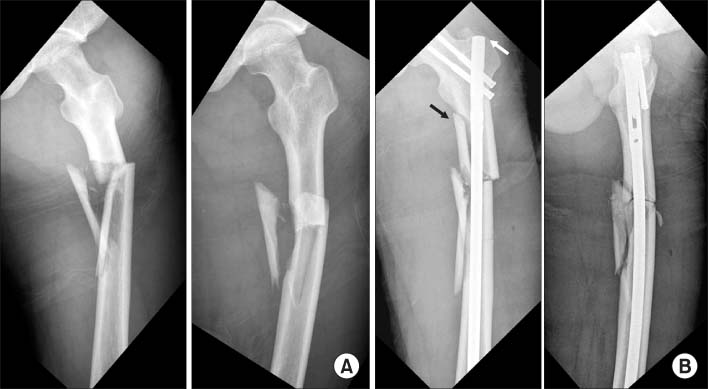J Korean Orthop Assoc.
2014 Aug;49(4):272-277. 10.4055/jkoa.2014.49.4.272.
Iatrogenic Femur Proximal Shaft Fracture during Nailing Using Lateral Entry Portal on Femur Shaft Fracture
- Affiliations
-
- 1Department of Orthopaedic Surgery, School of Medicine, Chosun University, Gwangju, Korea. leekci@chosun.ac.kr
- KMID: 2185182
- DOI: http://doi.org/10.4055/jkoa.2014.49.4.272
Abstract
- PURPOSE
We attempted to determine the cause of iatrogenic fractures and to prevent their occurrence during nailing using lateral entry portal on femur shaft fracture.
MATERIALS AND METHODS
We conducted a retrospective study of 160 patients who had been treated with nailing using a lateral entry portal for femur shaft fractures. We compared 18 patients (group 1) with iatrogenic fractures on the femur proximal portion with 18 patients (group 2) who had no fracture, and then surveyed and analyzed the characters of the fracture, position of the portal, nail size, and complications.
RESULTS
In distribution of primary femur shaft fractures, there were eight cases of proximal portion, nine cases of mid-portion, and one case of distal portion. In that of iatrogenic fractures, there were nine cases of medial fractures, five cases of lateral fractures, four cases of anterior fractures. In the entry portal of group 1, mean 1.82 mm leaned to the lateral side in antero-posteriorview, mean 5 mm leaned to the anterior side in lateral view. Anterior leaning of the entry portal was statistically significant with iatrogenic fracture.
CONCLUSION
The more the entry portal leaned to the lateral and anterior side, the greater the frequency of occurrence of iatrogenic fractures. To prevent iatrognic fracture, through preoperative X-ray, we must have a precise understanding and measure anatomical bowing and variance of the femur, and must pay attention to operative procedures during the operation.
MeSH Terms
Figure
Reference
-
1. Küntscher G. Die Marknagelung von Knochenbrüchen. Langenbecks Archive Klin Chir. 1940; 200:443–455.
Article2. Klemm K, Schellmann WD. Dynamic and static locking of the intramedullary nail. Monatsschr Unfallheilkd Versicher Versorg Verkehrsmed. 1972; 75:568–575.3. Winquist RA, Hansen ST Jr, Clawson DK. Closed intramedullary nailing of femoral fractures. A report of five hundred and twenty cases. J Bone Joint Surg Am. 1984; 66:529–539.
Article4. McKee MD, Waddell JP. Intramedullary nailing of femoral fractures in morbidly obese patients. J Trauma. 1994; 36:208–210.
Article5. Ostrum RF. A greater trochanteric insertion site for femoral intramedullary nailing in lipomatous patients. Orthopedics. 1996; 19:337–340.
Article6. Ansari Moein CM, Verhofstad MH, Bleys RL, van der Werken C. Soft tissue injury related to choice of entry point in antegrade femoral nailing: piriform fossa or greater trochanter tip. Injury. 2005; 36:1337–1342.
Article7. Ostrum RF, Marcantonio A, Marburger R. A critical analysis of the eccentric starting point for trochanteric intramedullary femoral nailing. J Orthop Trauma. 2005; 19:681–686.
Article8. Ricci WM, Devinney S, Haidukewych G, Herscovici D, Sanders R. Trochanteric nail insertion for the treatment of femoral shaft fractures. J Orthop Trauma. 2005; 19:511–517.
Article9. Ricci WM, Schwappach J, Tucker M, et al. Trochanteric versus piriformis entry portal for the treatment of femoral shaft fractures. J Orthop Trauma. 2006; 20:663–667.
Article10. Robinson CM, Houshian S, Khan LA. Trochanteric-entry long cephalomedullary nailing of subtrochanteric fractures caused by low-energy trauma. J Bone Joint Surg Am. 2005; 87:2217–2226.
Article11. Alho A, Strømsøe K, Ekeland A. Locked intramedullary nailing of femoral shaft fractures. J Trauma. 1991; 31:49–59.
Article12. Johnson KD, Tencer AF, Sherman MC. Biomechanical factors affecting fracture stability and femoral bursting in closed intramedullary nailing of femoral shaft fractures, with illustrative case presentations. J Orthop Trauma. 1987; 1:1–11.
Article13. Tencer AF, Sherman MC, Johnson KD. Biomechanical factors affecting fracture stability and femoral bursting in closed intramedullary rod fixation of femur fractures. J Biomech Eng. 1985; 107:104–111.
Article14. Papadakis SA, Zalavras C, Mirzayan R, Shepherd L. Undetected iatrogenic lesions of the anterior femoral shaft during intramedullary nailing: a cadaveric study. J Orthop Surg Res. 2008; 3:30.
Article15. Bohler L, Tretter HL. Medullary nailing of Küntscher. Baltimore: Williams & Wilkins Co;1948. p. 81.16. Harper MC, Carson WL. Curvature of the femur and the proximal entry point for an intramedullary rod. Clin Orthop Relat Res. 1987; 220:155–161.
Article17. Browner B, Wiss DA. The Grosse-Kempf locking nail for the femur. In : Browner BD, Edwards CC, editors. The science and practice of intramedullary nailing. Philadelphia: Lea & Febiger;1987. Vol. 1:p. 150–159.18. Bick EM. The intramedullary nailing of fractures by G. Küntscher. Translation of article in Archiv für Klinische Chirurgie, 200:443, 1940. Clin Orthop Relat Res. 1968; 60:5–12.19. Gausepohl T, Pennig D, Koebke J, Harnoss S. Antegrade femoral nailing: an anatomical determination of the correct entry point. Injury. 2002; 33:701–705.
Article20. Oh IS, Ko JH, Kang KD, Kim SH, Moon DH. Problems and complication after interlocking intramedullary nailing for femoral shaft fracture. J Korean Soc Fract. 1996; 9:547–556.21. Linke B, Ansari Moein C, Bösl O, et al. Lateral insertion points in antegrade femoral nailing and their influence on femoral bone strains. J Orthop Trauma. 2008; 22:716–722.
Article22. Carr JB, Williams D, Richards M. Lateral decubitus positioning for intramedullary nailing of the femur without the use of a fracture table. Orthopedics. 2009; 32:doi: 10.3928/01477447-20090818-05.
Article23. Kim JW, Byun SE, Oh WH, Kim JJ. Bursting fracture of the proximal femur during insertion of unreamed femoral nail for femur shaft fracture: a case report. J Korean Fract Soc. 2010; 23:227–231.
- Full Text Links
- Actions
-
Cited
- CITED
-
- Close
- Share
- Similar articles
-
- Femur Neck Fracture during Closed Medullary Nailing of Femur Shaft Fracture: A Report of Two Cases
- Bursting Fracture of the Proximal Femur during Insertion of Unreamed Femoral Nail for Femur Shaft Fracture: A Case Report
- Femur Neck Fracture during Closed Nailing of Femur Shaft Fracture
- Interlocking Intramedullary Nailing Versus conventional Kuntscher Intramedullary Nailing for Fracture of the Femoral Shaft
- Results of Intramedullary Nailing of Femoral Shaft Fracture: Trochanteric Entry Portal (Sirus Nail) versus Piriformis Entry Portal (M/DN Nail)


